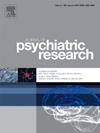Persons at risk for psychosis overestimate social functioning compared to persons with major depressive disorder and community controls
IF 3.7
2区 医学
Q1 PSYCHIATRY
引用次数: 0
Abstract
Poor insight is common in persons with psychosis, but treatment can improve insight. Individuals with psychosis who exhibit better insight have better social functioning, reduced negative symptoms, and paradoxically worse depression. There is limited research investigating insight among persons at clinical high risk for psychosis (CHR).
Understanding the relationship between insight, social functioning, negative symptoms, and depression might inform treatment. We focused on introspective bias (IB), the overestimation or underestimation of social functioning. Persons with CHR (N = 36), Major Depressive Disorder (MDD; N = 164), and community controls (N = 60) were recruited from the Multisite Assessment of Psychosis-risk Study and completed clinical interviews and self-report instruments. The estimation type was operationalized by whether a person was above or below the standardized mean difference between self-reported and interviewer-rated social functioning.
We hypothesized that 1) persons at CHR would have less depressive symptom severity than those with MDD diagnoses, but more depressive symptom severity than control participants accounting for IB within diagnostic groups, 2) CHR and MDD participants would endorse higher levels of negative symptoms, viewed transdiagnostically (e.g., anhedonia, avolition), than controls but not each other, 3) overestimators would endorse higher levels of negative symptoms and depression than underestimators, 4) CHR participants would have the greatest proportions of overestimators, MDD would have the greatest proportion of underestimators, and control participants would have equal proportions of under- and overestimators.
Those at CHR had more overestimators, overestimators overall had worse depression and negative symptoms, and diagnostic group membership did not impact the effects of IB on symptoms. This study suggests that IB has clinically relevant correlates but is not a primary treatment target for persons at CHR.
求助全文
约1分钟内获得全文
求助全文
来源期刊

Journal of psychiatric research
医学-精神病学
CiteScore
7.30
自引率
2.10%
发文量
622
审稿时长
130 days
期刊介绍:
Founded in 1961 to report on the latest work in psychiatry and cognate disciplines, the Journal of Psychiatric Research is dedicated to innovative and timely studies of four important areas of research:
(1) clinical studies of all disciplines relating to psychiatric illness, as well as normal human behaviour, including biochemical, physiological, genetic, environmental, social, psychological and epidemiological factors;
(2) basic studies pertaining to psychiatry in such fields as neuropsychopharmacology, neuroendocrinology, electrophysiology, genetics, experimental psychology and epidemiology;
(3) the growing application of clinical laboratory techniques in psychiatry, including imagery and spectroscopy of the brain, molecular biology and computer sciences;
 求助内容:
求助内容: 应助结果提醒方式:
应助结果提醒方式:


